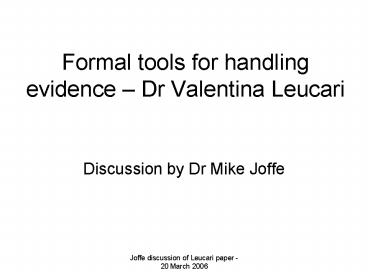Formal tools for handling evidence - PowerPoint PPT Presentation
1 / 11
Title:
Formal tools for handling evidence
Description:
Formal tools for handling evidence Dr Valentina Leucari. Discussion by Dr Mike Joffe ... (b) how to interrelate them to manage boundary compatibility ... – PowerPoint PPT presentation
Number of Views:56
Avg rating:3.0/5.0
Title: Formal tools for handling evidence
1
Formal tools for handling evidence Dr Valentina
Leucari
- Discussion by Dr Mike Joffe
2
Strengths of the paper
- comparing and contrasting different types of
graphical method is useful Bayesian networks
and Wigmore charts here - decomposing large models into smaller component
ones is very useful - the idea of having modular components what the
paper calls recurrent structures of evidence
could be extremely valuable
3
Fundamental attributes
- Schum
- relevance
- (2) credibility
- (3) strength
- p18 credibility (2) is represented by
likelihood ratios (3) - p33 no conditional independence (2) in Wigmore
charts, but still notion of relevance (1) - does this mean that strength (3) corresponds to
value of information (1)?
- Bayesian networks
- value of information
- (2) conditional probability tables
- (3) likelihood ratio
4
Explaining away where knowledge of one being
true lowers the probability of the other being
true
X3
X2
X4
X3 Sacco was involved in other crimes X2 Sacco
was involved in this crime X4 Sacco intended to
escape from the police when they arrested him
5
Potential problems I
- there could be other reasons for X4 (apart from
the policeman making this up), e.g. a
generalisation everyone fears the police, or
immigrants are treated as suspect or Saccos
political activity caused him to fear arrest, or
Sacco was paranoid - if Sacco were involved in other crimes (X3), this
might increase not decrease the level of
suspicion re this crime (X2).
6
Potential problems II
- also, its not clear from the charts what the
process is e.g. the chart for explaining away
(fig 3.11) looks similar to that for the filter
fragment (fig 3.9) and to that for
Event/Competence/Sensation (fig 3.7) etc - and how would this be interpreted in the case of
a causal model? interpretation is clear when
its a case of a belief making another less
likely (p6 A model can be causal)
7
Different languages I
- conditional probabilities (or more generally,
joint distributions) are in themselves
non-directional a direction (arrow-head) is
only present if imposed (e.g. blocks in graphical
models) - are we dealing with objective causal relations
here, or subjective belief systems? or both?
Bayesian networks are a process model
intended to capture a complex process by which
some series of events could have been generated
(Schum 2005 see p33)
8
A typology of graphical methods
- THOUGHT PROCESSES generalisability requires
justification of structure, links, etc - BAYES NETS correct subjective beliefs about
objective/quve causal relationships - CAUSAL RELATIONSHIPS arrows that represent
causation in the world combines a priori
specification and empirical testing - STATISTICAL ASSOCIATIONS represent joint
distributions only links non-directional
9
Different languages II
- different languages (here verbal reasoning and
the laws of probability) the questions are - (a) when and how to use each of them
- (b) how to interrelate them to manage boundary
compatibility
10
Grouping of items of evidence
- the suggestion in section 6.2 (page 37) that
items of evidence could be grouped into Witness
evidence, Physical evidence and Consciousness of
guilt evidence is problematic it would be
better to group items according to sub-stories,
e.g. whether the suspect was present, who hit the
guard, etc - more broadly, I would welcome the idea of
alternative stories being made more explicit
11
How special is Law?
- in this programme, we have focused a great deal
on legal examples what special considerations
does this introduce? - we should consider using journalism as a focus
it is more rooted in commonsense science,
undistorted by arbitrary rules of evidence
(although in practice distorted by
commercialism), and not constrained to the guilt
or not of particular people - responsibility not culpability































